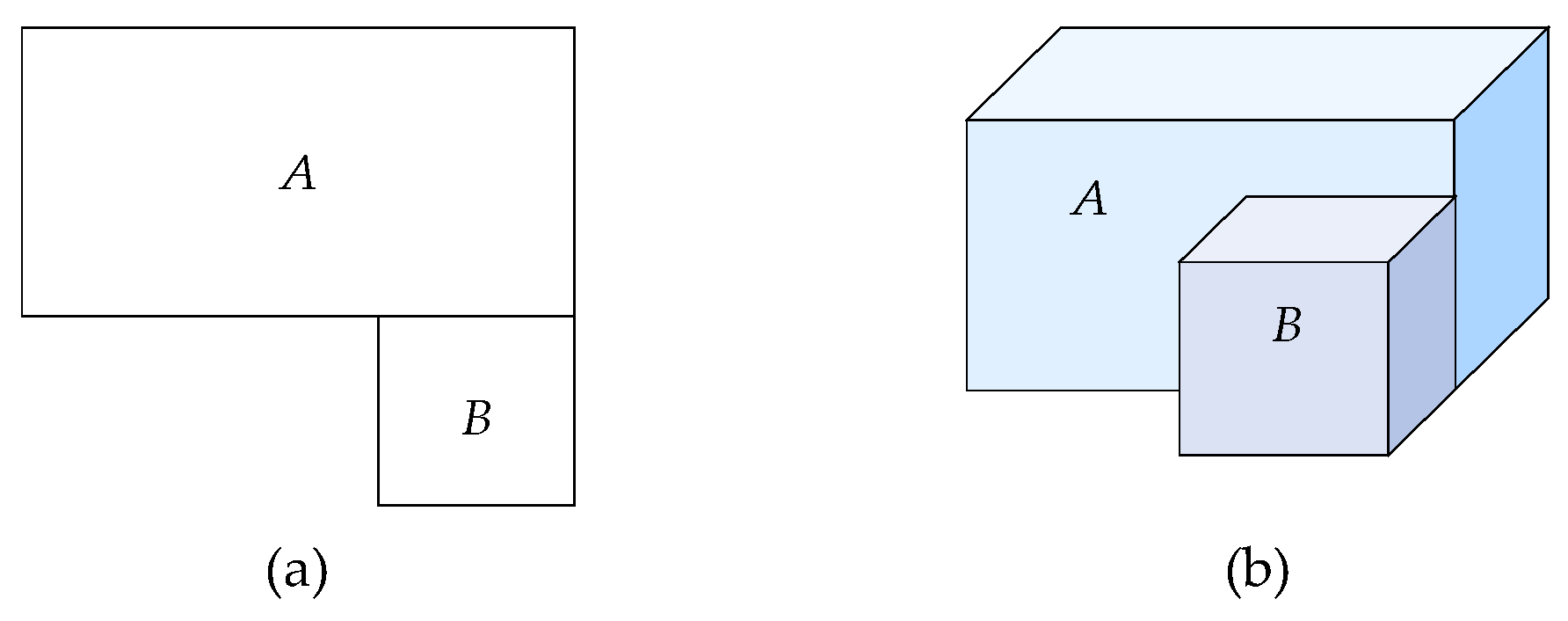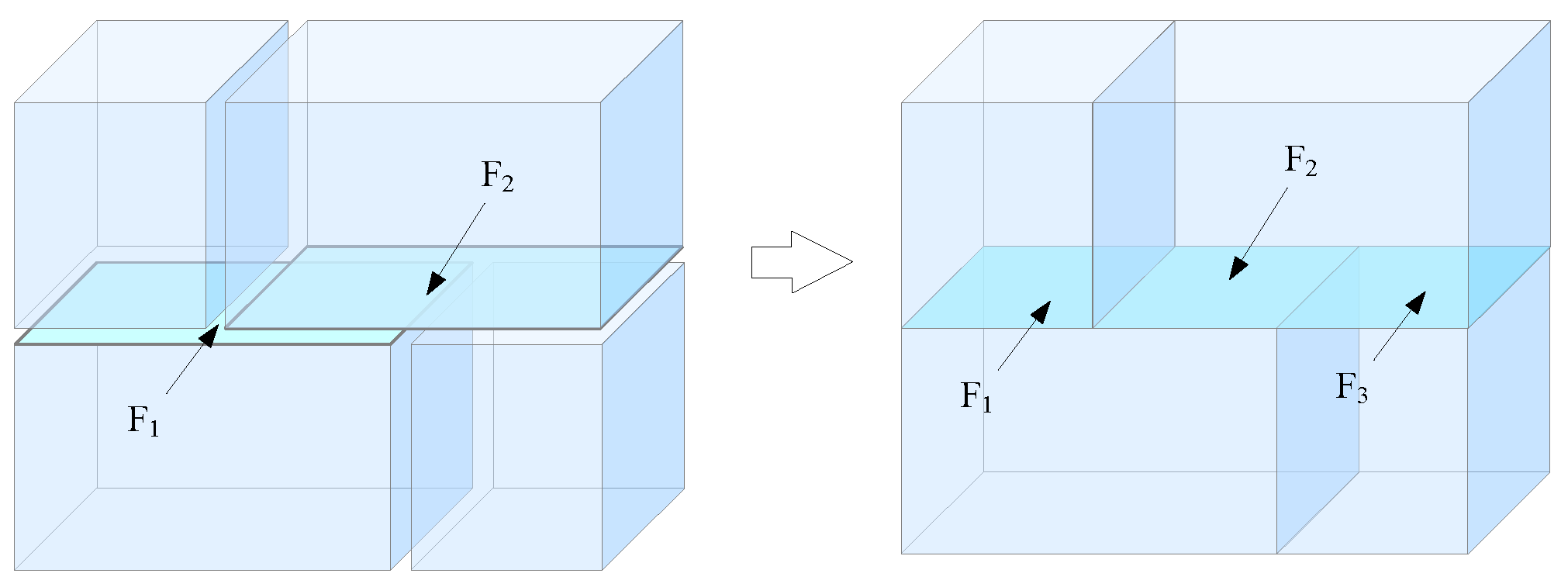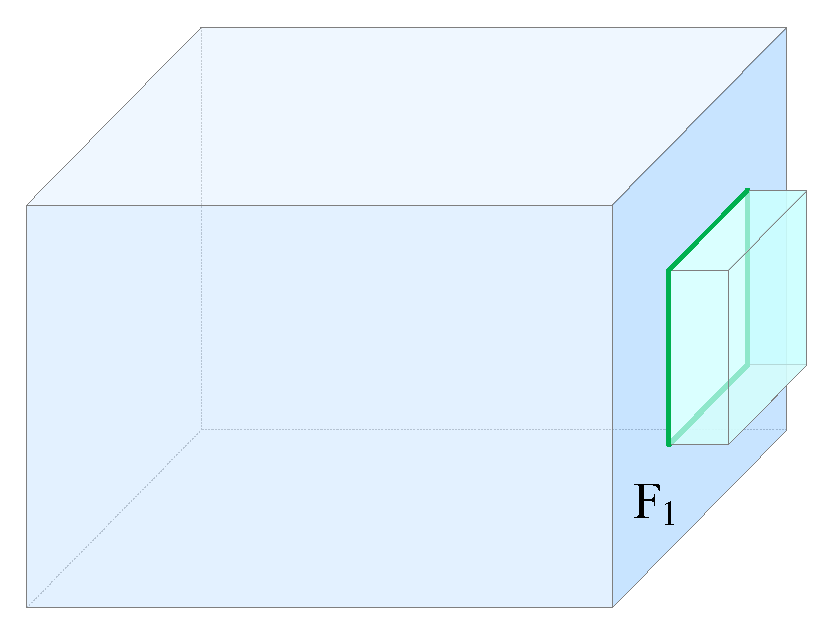Construction of 3D Indoor Topological Models Based on Improved Face Sorting
Abstract
1. Introduction
2. Background and Related Work
3. Three-Dimensional Indoor Topological Data Model Based on CityGML
3.1. Description of 3D Indoor Spaces Based on CityGML
3.2. Three-Dimensional Indoor Topological Data Model
4. Construction of 3D Indoor Topological Relationships Based on Improved Face Sorting
4.1. Prerequisites for the Construction of Volumetric Objects
4.2. Face Sorting Based on Vector Products
4.2.1. Introduction of Vector Products
4.2.2. Sorting Faces Set Based on Vector Products
4.3. Construction of Volumetric Objects
5. Implementation
5.1. Experimental Data
5.2. Experiment on the Construction of 3D Indoor Topological Relationships
5.3. Comparative Experiment of the Construction of 3D Topological Relationships
5.4. Information Inquiry for Indoor Spaces
6. Conclusions and Future Work
Author Contributions
Funding
Data Availability Statement
Conflicts of Interest
References
- Zheng, Z.; Sun, X.; Wen, Z.; Wang, X.; Fan, W.; Yan, H.; Li, Y. Indoor Localization and Trajectory Correction with Point Cloud-Derived Backbone Map. Int. J. Appl. Earth Obs. Geoinf. 2024, 129, 103783. [Google Scholar] [CrossRef]
- Wong, M.O.; Lee, S. Indoor Navigation and Information Sharing for Collaborative Fire Emergency Response with BIM and Multi-User Networking. Autom. Constr. 2023, 148, 104781. [Google Scholar] [CrossRef]
- Liu, L.; Zlatanova, S. A Spatial Data Model for Accessibility with Indoor Temporal Changes. Trans. GIS 2022, 26, 3277–3294. [Google Scholar] [CrossRef]
- Tran, H.; Khoshelham, K.; Kealy, A. Geometric Comparison and Quality Evaluation of 3D Models of Indoor Environments. ISPRS J. Photogramm. Remote Sens. 2019, 149, 29–39. [Google Scholar] [CrossRef]
- Kutzner, T.; Chaturvedi, K.; Kolbe, T.H. CityGML 3.0: New Functions Open Up New Applications. PFG—J. Photogramm. Remote Sens. Geoinf. Sci. 2020, 88, 43–61. [Google Scholar] [CrossRef]
- Yan, J.; Zlatanova, S.; Diakité, A. A Unified 3D Space-Based Navigation Model for Seamless Navigation in Indoor and Outdoor. Int. J. Digit. Earth 2021, 14, 985–1003. [Google Scholar] [CrossRef]
- Gröger, G.; Plümer, L. Derivation of 3D Indoor Models by Grammars for Route Planning. Photogrammetrie-Fernerkundung-Geoinformation 2010, 2010, 191–206. [Google Scholar] [CrossRef]
- OGC City Geography Markup Language (CityGML) Part 1: Conceptual Model Standard. Available online: https://www.ogc.org/standard/citygml/ (accessed on 22 October 2024).
- Gröger, G.; Plümer, L. CityGML—Interoperable Semantic 3D City Models. ISPRS J. Photogramm. Remote Sens. 2012, 71, 12–33. [Google Scholar] [CrossRef]
- OGC Geography Markup Language (GML) Encoding Standard. Available online: https://www.ogc.org/standard/gml/ (accessed on 22 October 2024).
- ISO 19107; Geographic Information—Spatial Schema. Available online: https://www.iso.org/standard/66175.html (accessed on 22 October 2024).
- Chen, S.; Zhang, W.; Wong, N.H.; Ignatius, M. Combining CityGML Files and Data-Driven Models for Microclimate Simulations in a Tropical City. Build. Environ. 2020, 185, 107314. [Google Scholar] [CrossRef]
- Biljecki, F.; Lim, J.; Crawford, J.; Moraru, D.; Tauscher, H.; Konde, A.; Adouane, K.; Lawrence, S.; Janssen, P.; Stouffs, R. Extending CityGML for IFC-Sourced 3D City Models. Autom. Constr. 2021, 121, 103440. [Google Scholar] [CrossRef]
- Dutta, A.; Saran, S.; Senthil Kumar, A. Development of CityGML Application Domain Extension for Indoor Routing and Positioning. J. Indian Soc. Remote Sens. 2017, 45, 993–1004. [Google Scholar] [CrossRef]
- Sun, Q.; Zhou, X.; Hou, D. A Simplified CityGML-Based 3D Indoor Space Model for Indoor Applications. Appl. Sci. 2020, 10, 7218. [Google Scholar] [CrossRef]
- Li, L.; Luo, F.; Zhu, H.; Ying, S.; Zhao, Z. A Two-Level Topological Model for 3D Features in CityGML. Comput. Environ. Urban Syst. 2016, 59, 11–24. [Google Scholar] [CrossRef]
- Giovanella, A.; Bradley, P.E.; Wursthorn, S. Evaluation of Topological Consistency in CityGML. ISPRS Int. J. Geo-Inf. 2019, 8, 278. [Google Scholar] [CrossRef]
- Biljecki, F.; Ledoux, H.; Stoter, J. Improving the Consistency of Multi-LOD CityGML Datasets by Removing Redundancy. In 3D Geoinformation Science; Breunig, M., Al-Doori, M., Butwilowski, E., Kuper, P.V., Benner, J., Haefele, K.H., Eds.; Lecture Notes in Geoinformation and Cartography; Springer International Publishing: Cham, Switzerland, 2015; pp. 1–17. [Google Scholar]
- Biljecki, F.; Ledoux, H.; Du, X.; Stoter, J.; Soon, K.H.; Khoo, V.H.S. The most common geometric and semantic errors in CityGML datasets. In Proceedings of the 11th 3D Geoinfo Conference, Athens, Greece, 20–21 October 2016; ISPRS Annals of the Photogrammetry, Remote Sensing and Spatial Information Sciences. pp. 13–22. [Google Scholar] [CrossRef]
- Horna, S.; Meneveaux, D.; Damiand, G.; Bertrand, Y. Consistency Constraints and 3D Building Reconstruction. Comput.-Aided Des. 2009, 41, 13–27. [Google Scholar] [CrossRef]
- Ledoux, H.; Meijers, M. Topologically Consistent 3D City Models Obtained by Extrusion. Int. J. Geogr. Inf. Sci. 2011, 25, 557–574. [Google Scholar] [CrossRef]
- Arroyo Ohori, K.; Ledoux, H.; Stoter, J. A Dimension-Independent Extrusion Algorithm Using Generalised Maps. Int. J. Geogr. Inf. Sci. 2015, 29, 1166–1186. [Google Scholar] [CrossRef]
- Ding, Y.; Jiang, N.; Yu, Z.; Ma, B.; Shi, G.; Wu, C. Extrusion Approach Based on Non-Overlapping Footprints (EABNOF) for the Construction of Geometric Models and Topologies in 3D Cadasters. ISPRS Int. J. Geo-Inf. 2017, 6, 232. [Google Scholar] [CrossRef]
- Ding, Y.; Shao, H. Constructing Topological Models for Three-Dimensional and Dynamic Cadastral Management Systems Based on Generalized Maps. Arab. J. Geosci. 2020, 13, 1277. [Google Scholar] [CrossRef]
- Ying, S.; Guo, R.; Li, L.; Oosterom, P.V.; Ledoux, H.; Stoter, J. Design and Development of a 3D Cadastral System Prototype Based on the LADM and 3D Topology. In Proceedings of the 2nd International Workshop on 3D Cadastres, Delft, The Netherlands, 16–18 November 2011; pp. 167–188. [Google Scholar]
- Ying, S.; Li, L.; Guo, R. Building 3D Cadastral System Based on 2D Survey Plans with SketchUp. Geo-Spat. Inf. Sci. 2011, 14, 129–136. [Google Scholar] [CrossRef]
- Guo, R.; Li, L.; Ying, S.; Luo, P.; He, B.; Jiang, R. Developing a 3D Cadastre for the Administration of Urban Land Use: A Case Study of Shenzhen, China. Comput. Environ. Urban Syst. 2013, 40, 46–55. [Google Scholar] [CrossRef]
- Ying, S.; Guo, R.; Li, L.; Van Oosterom, P.; Stoter, J. Construction of 3D Volumetric Objects for a 3D Cadastral System. Trans. GIS 2015, 19, 758–779. [Google Scholar] [CrossRef]
- Ying, S.; Guo, R.; Yang, J.; He, B.; Zhao, Z.; Jin, F. 3D Space Shift from CityGML LoD3-Based Multiple Building Elements to a 3D Volumetric Object. ISPRS Int. J. Geo-Inf. 2017, 6, 17. [Google Scholar] [CrossRef]
- Alexander, C.; Smith-Voysey, S.; Jarvis, C.; Tansey, K. Integrating Building Footprints and LiDAR Elevation Data to Classify Roof Structures and Visualise Buildings. Comput. Environ. Urban Syst. 2009, 33, 285–292. [Google Scholar] [CrossRef]
- Ledoux, H.; Meijers, M. Extruding Building Footprints to Create Topologically Consistent 3D City Models. In Urban and Regional Data Management—UDMS Annual 2009; Krek, A., Rumor, M., Zlatanova, S., Fendel, E.M., Eds.; Taylor & Francis: London, UK, 2009; pp. 39–48. [Google Scholar]
- Kazar, B.M.; Kothuri, R.; Van Oosterom, P.; Ravada, S. On Valid and Invalid Three-Dimensional Geometries. In Advances in 3D Geoinformation Systems; Van Oosterom, P., Zlatanova, S., Penninga, F., Fendel, E.M., Eds.; Lecture Notes in Geoinformation and Cartography; Springer: Berlin/Heidelberg, Germany, 2008; pp. 19–46. [Google Scholar]
- Thompson, R.; van Oosterom, P. Modelling and Validation of 3D Cadastral Objects. In Urban and Regional Data Management; Zlatanova, S., Ledoux, H., Fendel, E.M., Rumor, M., Eds.; CRC Press: Leiden, The Netherlands, 2011; pp. 7–23. [Google Scholar]
- Gröger, G.; Plümer, L. How to Achieve Consistency for 3D City Models. GeoInformatica 2011, 15, 137–165. [Google Scholar] [CrossRef]
- Ledoux, H. On the Validation of Solids Represented with the International Standards for Geographic Information. Comput.-Aided Civ. Infrastruct. Eng. 2013, 28, 693–706. [Google Scholar] [CrossRef]
- Karki, S.; Thompson, R.; McDougall, K. Development of Validation Rules to Support Digital Lodgement of 3D Cadastral Plans. Comput. Environ. Urban Syst. 2013, 40, 34–45. [Google Scholar] [CrossRef]
- Kremer, M.; Bommes, D.; Kobbelt, L. OpenVolumeMesh—A Versatile Index-Based Data Structure for 3D Polytopal Complexes. In Proceedings of the 21st International Meshing Roundtable; Jiao, X., Weill, J.-C., Eds.; Springer: Berlin/Heidelberg, Germany, 2013; pp. 531–548. [Google Scholar]




















| Iteration | Ordered Faces Set After Sorting | Unordered Faces Set Before Sorting |
|---|---|---|
| 0 | F0, F1, F2, F3, F4, F5, F6, F7 | |
| 1 | F0 | F1, F2, F3, F4, F5, F6, F7 |
| 2 | F1, F0 | F2, F3, F4, F5, F6, F7 |
| 3 | F1, F0, F2 | F3, F4, F5, F6, F7 |
| 4 | F1, F0, F2, F3 | F4, F5, F6, F7 |
| 5 | F1, F4, F0, F2, F3 | F5, F6, F7 |
| 6 | F1, F4, F0, F5, F2, F3 | F6, F7 |
| 7 | F6, F1, F4, F0, F5, F2, F3 | F7 |
| 8 | F6, F1, F4, F0, F5, F2, F7, F3 |
| Experimental Data | The Existing Method (Sec) | The Method Improved (Sec) |
|---|---|---|
| The first dataset | 10.4 | 6.9 |
| The second dataset | 16.7 | 10.8 |
Disclaimer/Publisher’s Note: The statements, opinions and data contained in all publications are solely those of the individual author(s) and contributor(s) and not of MDPI and/or the editor(s). MDPI and/or the editor(s) disclaim responsibility for any injury to people or property resulting from any ideas, methods, instructions or products referred to in the content. |
© 2025 by the authors. Published by MDPI on behalf of the International Society for Photogrammetry and Remote Sensing. Licensee MDPI, Basel, Switzerland. This article is an open access article distributed under the terms and conditions of the Creative Commons Attribution (CC BY) license (https://creativecommons.org/licenses/by/4.0/).
Share and Cite
Sun, Q.; Zhan, X.; Tang, P. Construction of 3D Indoor Topological Models Based on Improved Face Sorting. ISPRS Int. J. Geo-Inf. 2025, 14, 27. https://doi.org/10.3390/ijgi14010027
Sun Q, Zhan X, Tang P. Construction of 3D Indoor Topological Models Based on Improved Face Sorting. ISPRS International Journal of Geo-Information. 2025; 14(1):27. https://doi.org/10.3390/ijgi14010027
Chicago/Turabian StyleSun, Qun, Xinwu Zhan, and Pu Tang. 2025. "Construction of 3D Indoor Topological Models Based on Improved Face Sorting" ISPRS International Journal of Geo-Information 14, no. 1: 27. https://doi.org/10.3390/ijgi14010027
APA StyleSun, Q., Zhan, X., & Tang, P. (2025). Construction of 3D Indoor Topological Models Based on Improved Face Sorting. ISPRS International Journal of Geo-Information, 14(1), 27. https://doi.org/10.3390/ijgi14010027






